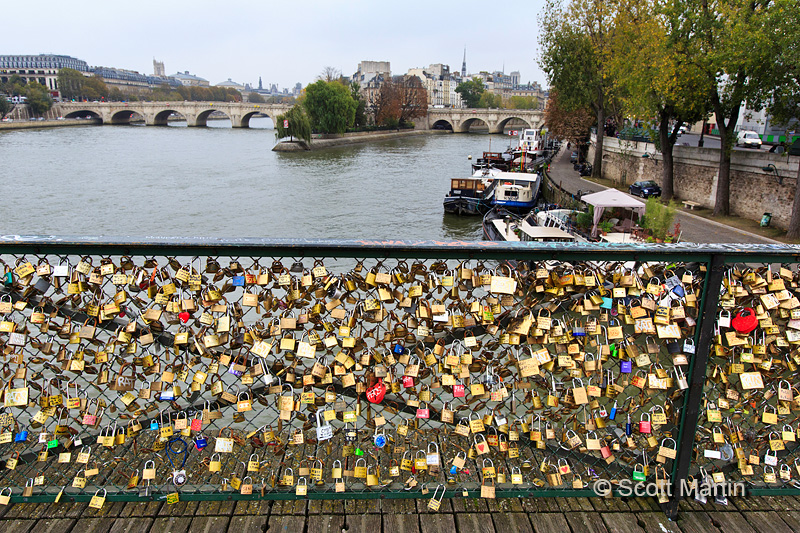
by Scott Martin Photography | Jan 14, 2014 | Blog, Cityscapes, Educational, Landscapes, Travel
After leaving The Louvre we moseyed along the north bank of the Seine until we arrived at a bridge that took us part way across the river to one of only two natural islands in the Seine River within Paris known as Île de la Cité. As we crossed the bridge in was impossible not to notice the thousands of locks, of every size, shape and style imaginable that were locked to the railings alongside the bridge.

Upon closer inspection each lock was emblazoned with the initial’s or names of the couples who attached the lock to the railing and no doubt pledged their love to each other while they tossed the keys into the river below. I couldn’t help but take a few pics of these locks.
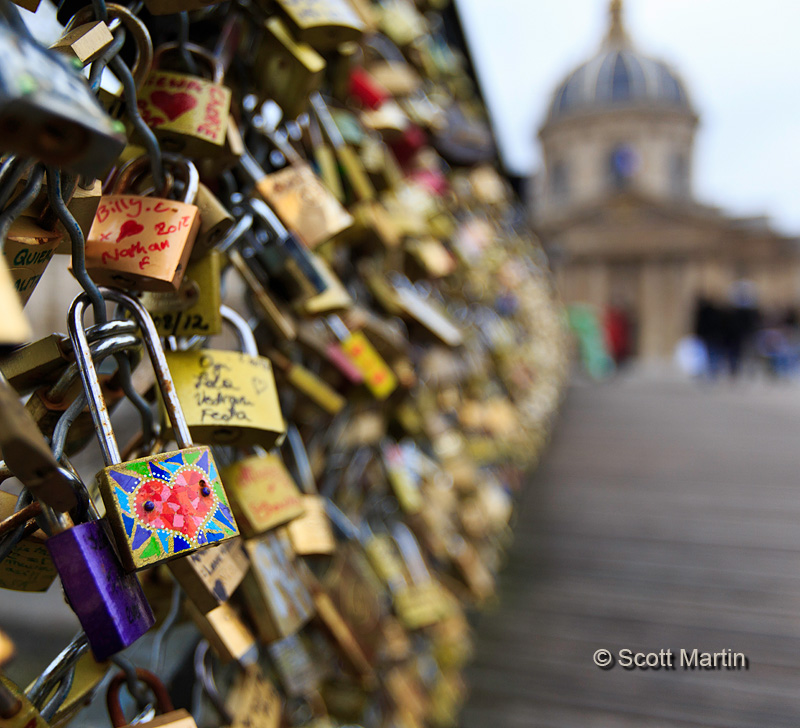
.
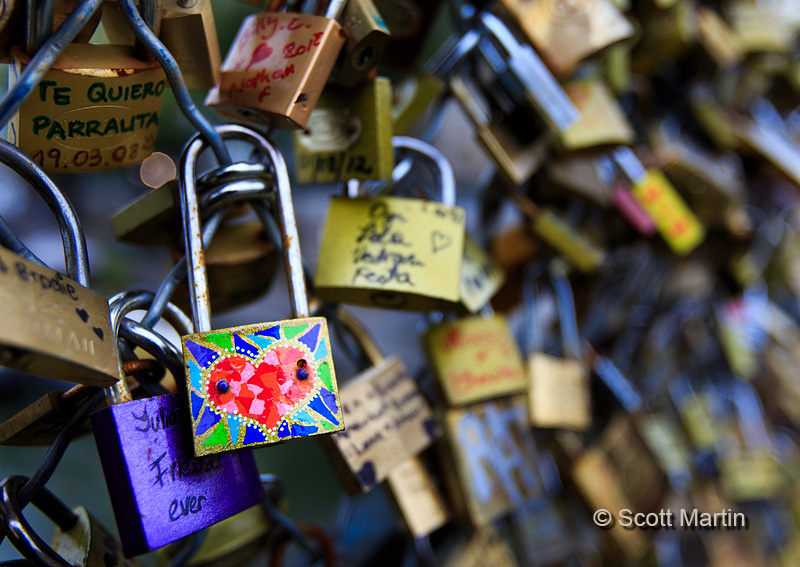
Île de la Cité is a small island that marks the geographic centre of the city and is where Paris was founded. The most famous building on the island is without doubt the cathedral Notre Dame de Paris (Our Lady of Paris) or simply Notre Dame. The cathedral is located in the geographic centre of Paris and there is a brass plaque in front of Note Dame that marks the spot from which all distances around the city are measured.
The western facade of Notre Dame provides the typical view of the building, however the day we were there large portable grandstands were set up in front of the cathedral which precluded a good vantage point for a picture.
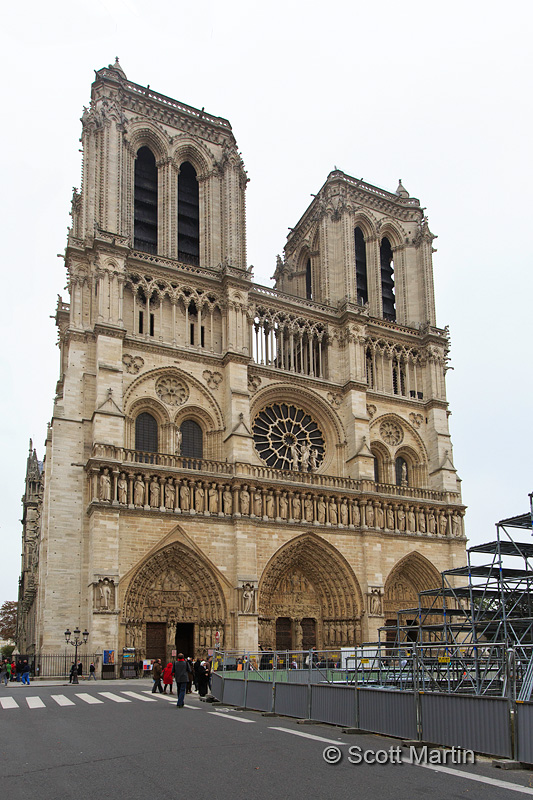
The cornerstone of the building was laid in 1163 and the western facade pictured above was finished in 1225 although the total structure was not completed until 1345. Although famous for the flying buttresses that support the library of the cathedral the western facade is what you visualize when you think about Notre Dame. The facade is large and impressive with its towers, rose window, balustrade, statues and three portals of entry. It measures 135′ wide and is 207′ high. The rose window in the centre of the facade is 31.5′ in diameter and forms a halo around the heads of a statue of Mary and Jesus which sits on the railing of the balustrade when viewed from the ground in front of the cathedral. Below the balustrade is a frieze that extends across the entire width of the facade, known as the Gallery of Kings containing twenty eight statues depicting the generations of Kings of Judah.

Below the Gallery of Kings are three large double sets of doors that form the main entrances, or portals, into the cathedral. The left (north) is the Portal of the Virgin (1210), the central Portal of the Last Judgement (1220) and the right Portal of Saint Anne (Mary’s mother) (1200). Each portal is framed by an ornate archway supported by columns or jambs that contain statues of Kings & Monarchs from Biblical times. Below are four at the Portal of Saint Anne.
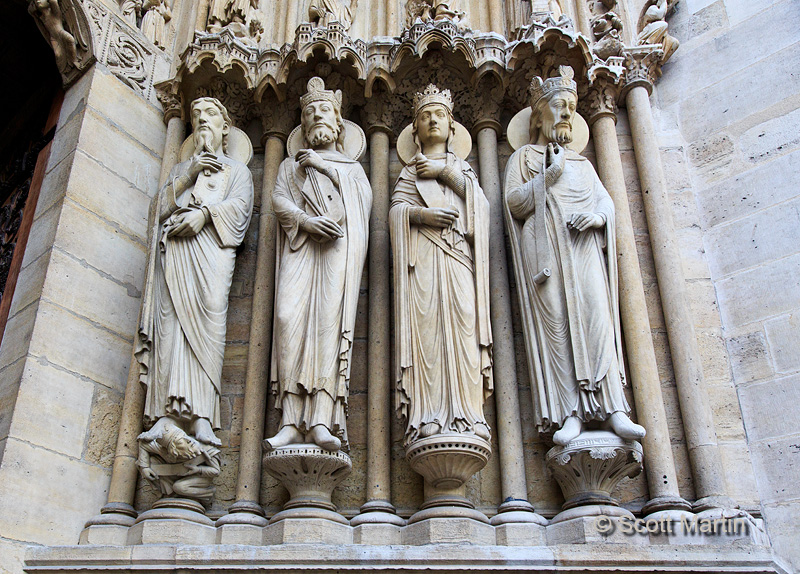
Flashes and tripods are not allowed in Notre Dame so very high ISO’s are required to generate exposure times fast enough to hand hold the camera in the deliberately dark interior (to prevent light degradation of the artefacts within). All of the interior images that follow were taken at ISO 4000 or more and I trust you enjoy these views from within Notre Dame.
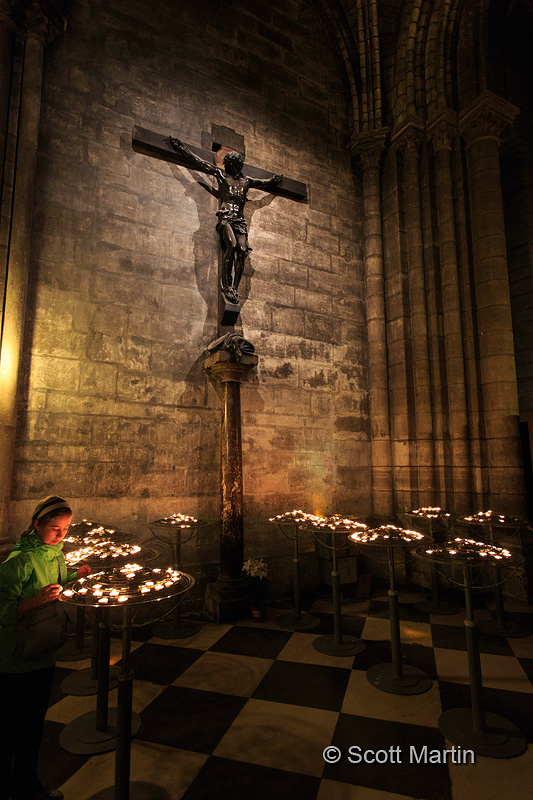
.
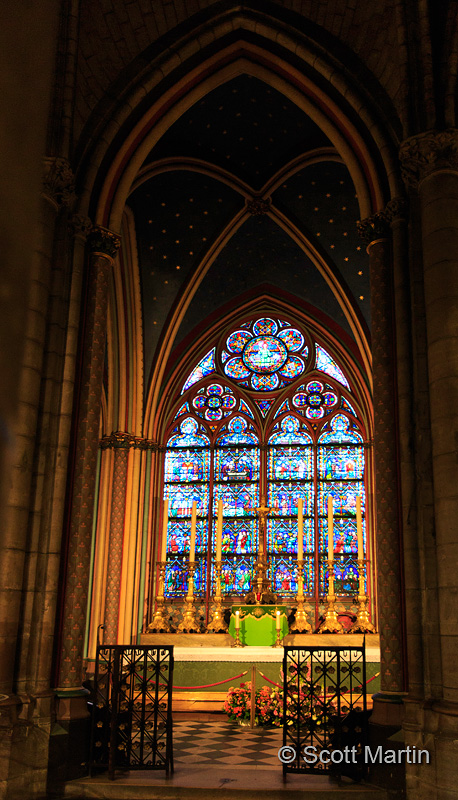
.
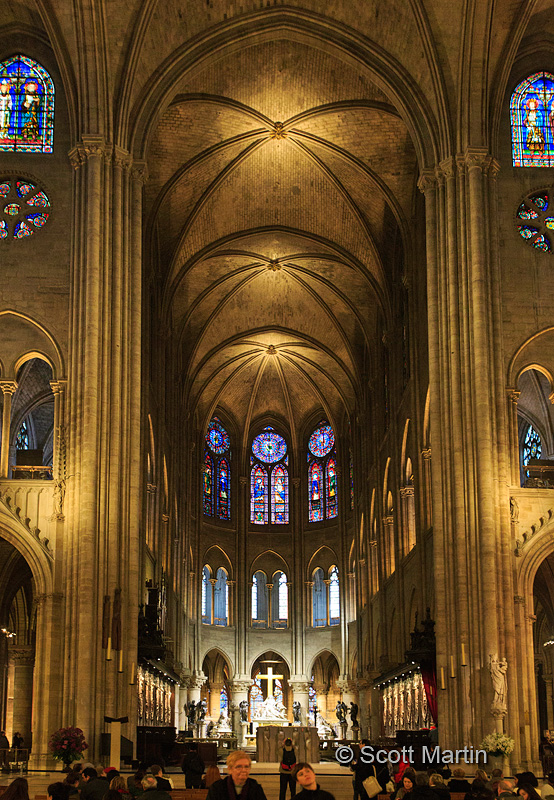
.
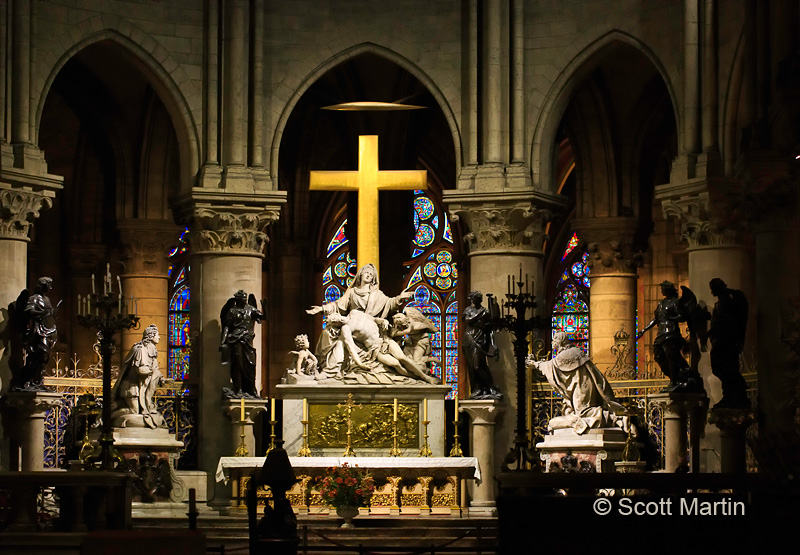
Notre Dame has two permanent and one portable organs. The great organ is said to be the most famous pipe organ in the world, having five keyboards, 190 stops and 8,000 pipes. The ‘smaller’ choir organ has two keyboards, thirty stops and 2,000 pipes.
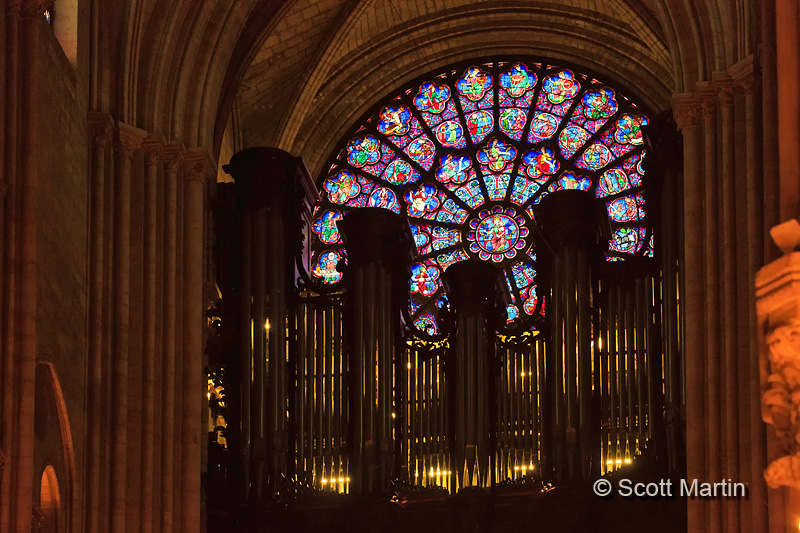
One can not walk through the cathedral and avoid thinking about Victor Hugo’s classic “The Hunchback of Notre Dame” and wondering where Quasimodo was. We could find no mention of him anywhere, however this next picture reminded me of him, probably because of the chandelier and the connection with the swinging chandelier in “Phantom of the Opera”….I know, same city, different building and completely different story 🙂
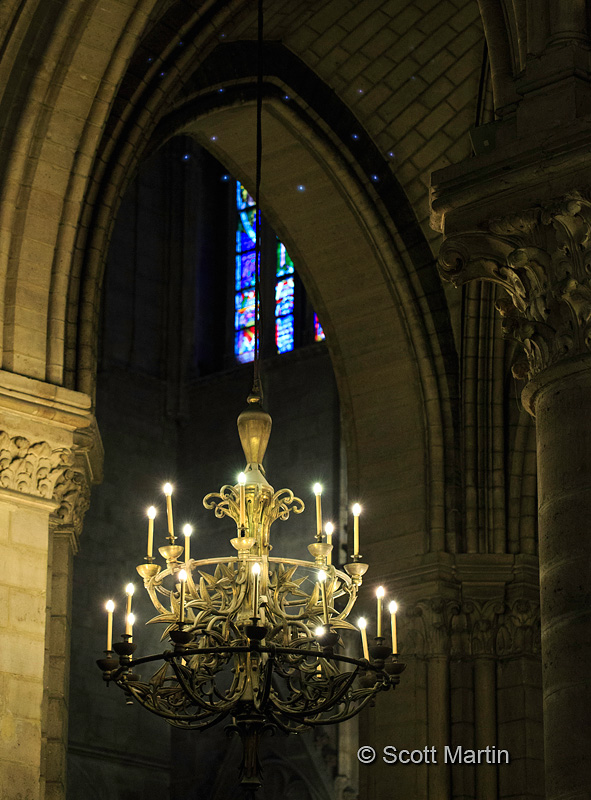
When shooting the interior of a large building like Notre Dame it is important to consider focal lengths as the photographic results are vastly different, and equally as impressive, at 16mm and 100mm. Its become our practice to make two passes through buildings like Notre Dame for a couple of reasons, first of all it takes a couple of trips through just to take in the magnificence of the structure and commit as much as possible to memory so it can be enjoyed over and over again. Looking at the building differently with each pass helps heighten your appreciation of the building as a whole as well. I take the first trip through ‘thinking wide’ and taking in the big picture and recording it with a 16-35 f2.8 zoom lens. The results of which are shown in the first three interior images above. The second trip through the building I think ‘detail’ and record it with a 100mm f2.8 macro lens which allows the recording of small details up close and big details from farther away. The last three images above were taken with the 100mm lens. The beauty of the 100mm macro is that it is a very small and therefore discreet lens that does not attract attention. It is also very light so carrying it around all day is not a hardship and thus it has found a permanent home in my travel camera bag. The only down side is that as a prime lens you must zoom and compose with your feet 🙂 If you don’t have this little stealth telephoto/macro in your bag I would highly recommend it to you.
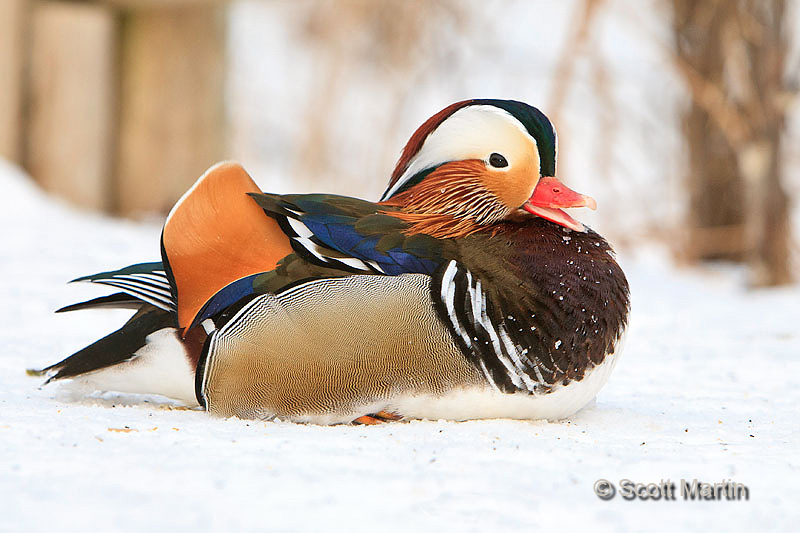
by Scott Martin Photography | Jan 4, 2014 | Birds, Blog, Shore Birds & Waterfowl, Wildlife
The Mandarin Duck is a local rarity and a bird I had never seen before in the wild so when a single drake showed up in Whitby it created quite a flurry of interest.
The Mandarin Duck is an East Asian perching duck found primarily in Russia, China and Japan. It is a medium sized duck and is closely related to the North American Wood Duck and is similar in that they both nest in empty tree cavities, sometimes as high as thirty feet above the ground. After the chicks are born the mother pushes them out of the tree and then leads them off to the nearest body of water. Mandarin Ducks are among the most beautiful and colourful ducks as the following pictures shows.

When shooting birds on the ground it is important to get the camera at their level in order to achieve the best results. The above shot was taken while lying down on the ground resting the 70-200mm lens on the palm of my hand. The next image was taken from a sitting/kneeling position to show the colour ranges and feathers detail on the dorsal aspect of the bird. Although the shot accomplishes the purpose you can clearly see the better perspective of the first image. So next time you are photographing anything on the ground, don’t forget to lie down and get the job done right!
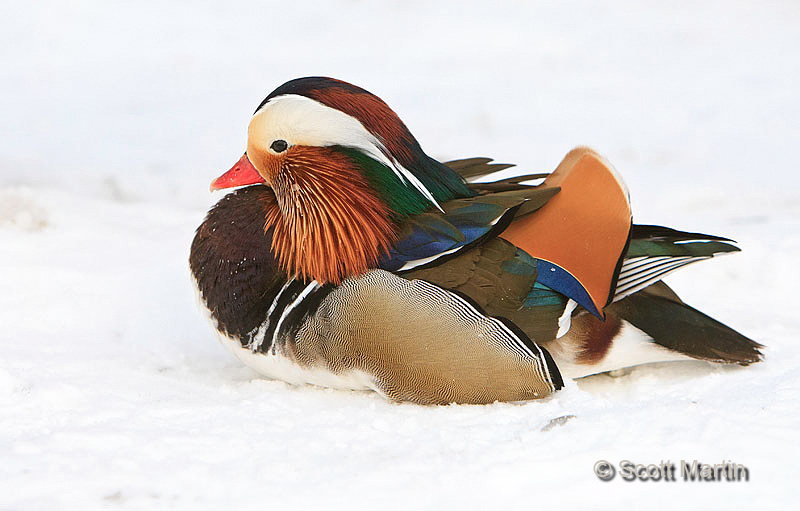
Although there are a few feral colonies of Mandarin Ducks in North America, they were probably created by the escape of bids from captive collections (i.e., zoos). It is unlikely they are a result of misplaced migration from East Asia. In all probability the Mandarin drake that arrived in Whitby is an escaped captive bird.
The only open water for this duck is a pool created by the fast flowing water from a couple of late drainage pipes that is only about thirty feet in diameter. This little Mandarin Duck shares the small pool with about a hundred Mallard ducks and a few Canada Geese so it was very difficult to get any images of the Mandarin alone in the water. The following three are the best I could do.
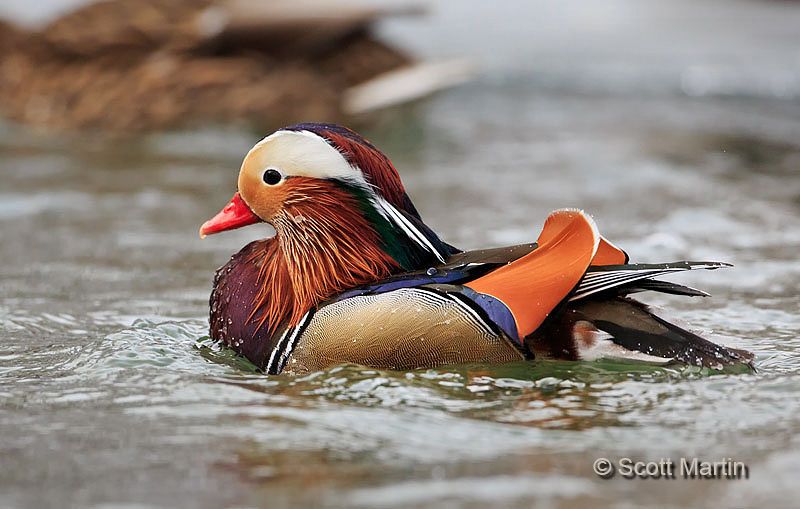
Frolicking
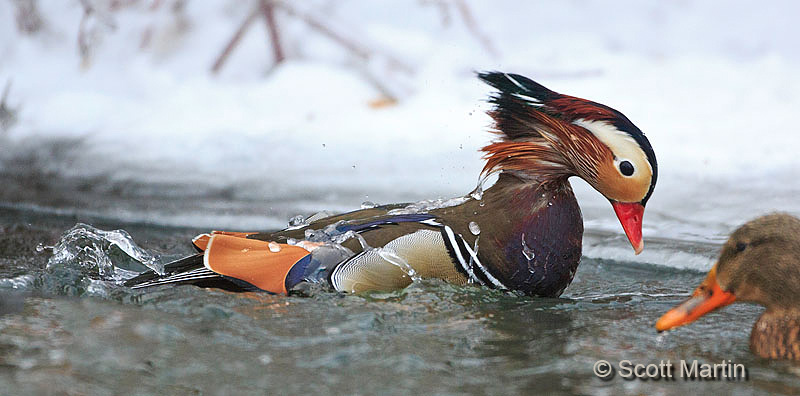
Water off a duck’s back!
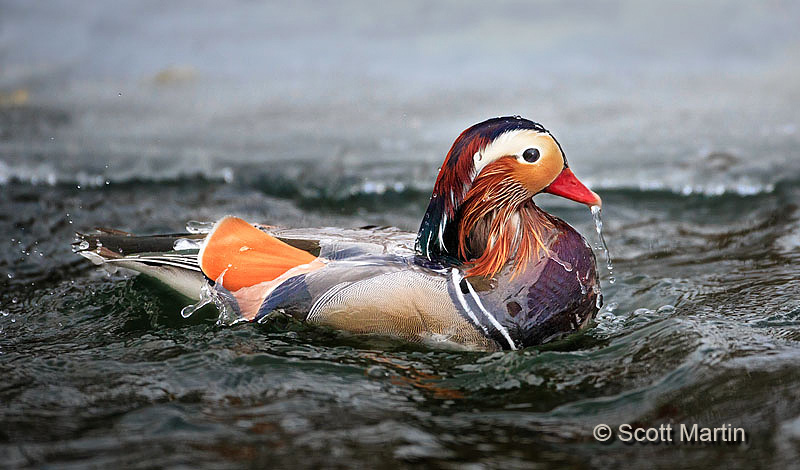
When photographing wildlife it is always best to take lots of exposures when the target is in your viewfinder as the spontaneous nature of wild animals often presents some interesting even humorous actions. This is completely different from landscape photography where the subject doesn’t move and you can invest as much time as necessary to plan, compose and execute the ‘perfect’ single image and then move on to the next shot.
Spontaneous ‘snapshots’ don’t have to be perfectly composed with tack sharp focus (although it helps) as long as the story the image tells or the smile that it creates is the overarching result of the photograph. Here are a couple of such snapshots obtained while photographing the Mandarin Duck this week. Although not typical images for posting on photography blog designed to showcase great photography, I do trust you enjoy them and they give you a smile.
Stepping out with the big boys! (this does provide a good perspective for appreciating the size of the Mandarin Duck).
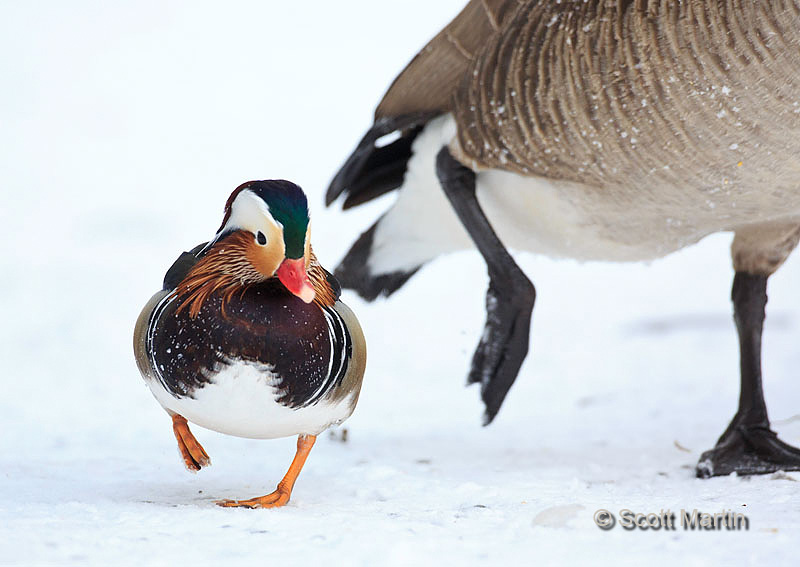
Where angels fear to tread.
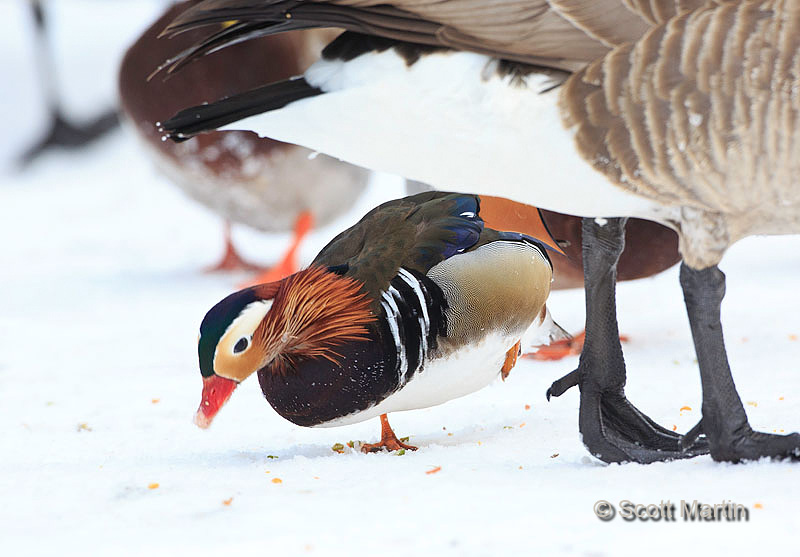
The first two images in this post were taken handheld with the 1D Mk III and 70-200mm/2.8, while the three shots of the duck on the water were using the 5D Mk III and 500mm/4, again handheld. Although these body/lens combinations may seem odd, some thought went into them. The 1D body has a crop factor of 1.3 meaning that a 100mm lens functions like a 100 x 1.3 = 130mm lens when attached to the crop body. So a crop body lengthens the effective reach of the lens compared to the same lens placed on a full frame camera like the 5D. Knowing that it was possible to get relatively close to the ducks, putting the crop body on the smaller lens and the full frame body on the longer lens created the optimal effective focal ranges for getting the best pics of the Mandarin Duck.
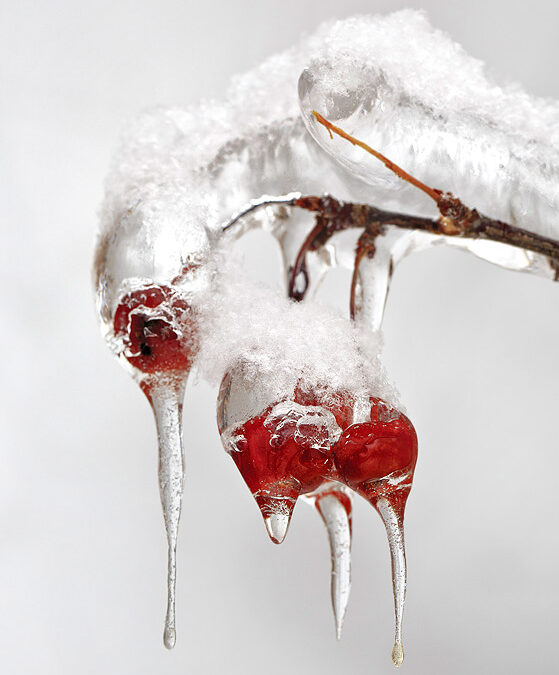
by Scott Martin Photography | Jan 1, 2014 | Blog, Educational, Landscapes, Naturescapes
Happy New Year to all of you who have followed this blog over the past year and I trust each and every one of you will enjoy a wonderful New Year in 2014, full of God’s blessings.
This will be a short post today and something completely different from the norm in that it will be a bit of a tutorial, so your feed back would be appreciated.
Christmas of 2013 in our area will forever be remembered for the ice storm that blanketed southern Ontario and caused power outages on a huge scale, affecting millions of people and leaving thousands of homes in the Greater Toronto Area without power for over a week. Our home in Oshawa was relatively unscathed, being without power for about half a day and an Ash tree in our front lawn suffering major damage (and perhaps may have to come down). Although the ice storm caused major destruction, it also allowed for some great photographs opportunities which actually lasted for three or four days before the sun came out and temperatures rose sufficiently to melt the ice. All of the images in today’s post are of a Flowering Crabapple tree located in the front yard of our home. Each image was taken using the Canon 5D MkIII and EF 100mm f/2.8L macro IS USM lens mounted on a tripod.
This first image is the final result after much experimentation to achieve the desired outcome; bright red Crabapples encased in ice with a snowy frosting and winter back ground.
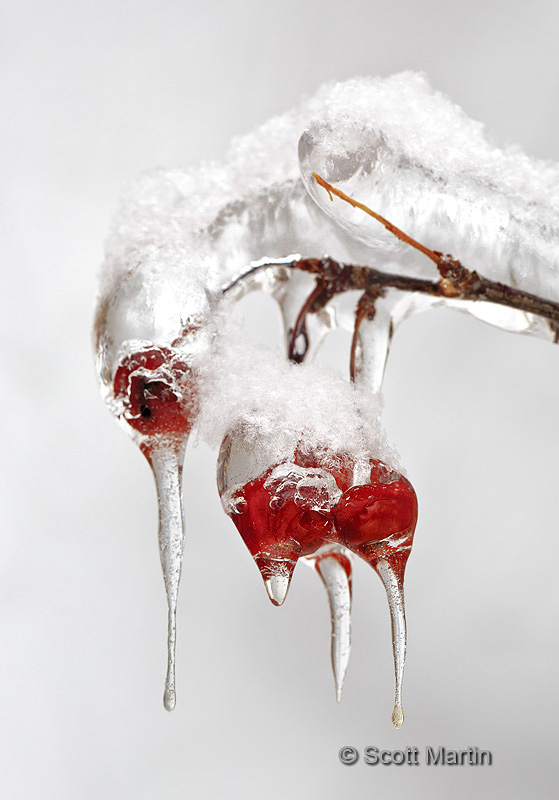
Its important to consider the back ground (BG) of every image taken and if possible develop a BG that adds to the effectiveness of the image by isolating the object of the photograph from the BG. Classically, look for uncluttered BG’s that are out of focus, factors that help create separation between the object and its surroundings and therefore draws one’s attention to the object of the photograph. Technically this can be accomplished by two methods; when possible increasing the distance between the object and and BG, and increasing the aperture on your lens (lower f-stop) which reduces the depth of field (DOF; the distance range perpendicular to the lens that remains in focus).
The next three images are all taken with the same camera position as the image above, however the BG is the brick siding of our next door neighbour’s house. They show the relationship between aperture and depth of field and that even when a BG is separated from the object and out of focus, colour has a huge impact on the final result!
f/32 ISO 100 1/2 sec (smallest lens aperture, maximum depth of field, bricks recognizable but out of focus due to distance from object).
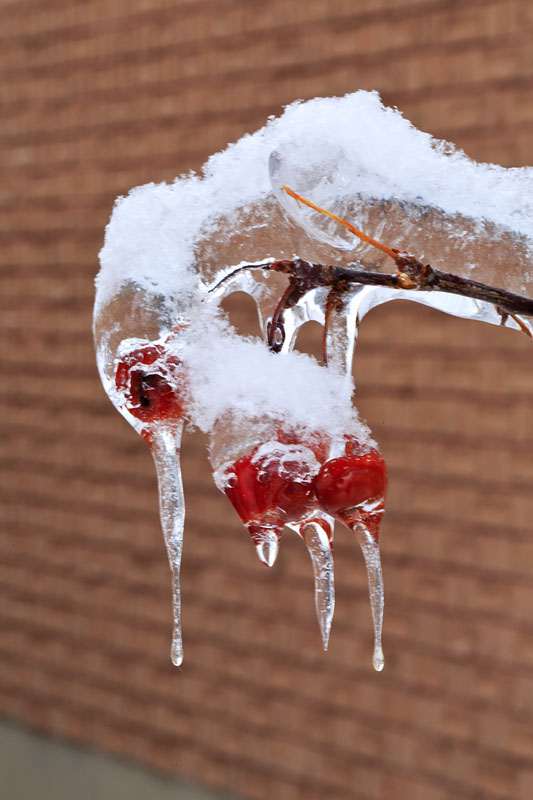
f/10 ISO 100 1/20 sec (less depth of field, bricks almost unrecognizable and crabapples in reasonable focus throughout)
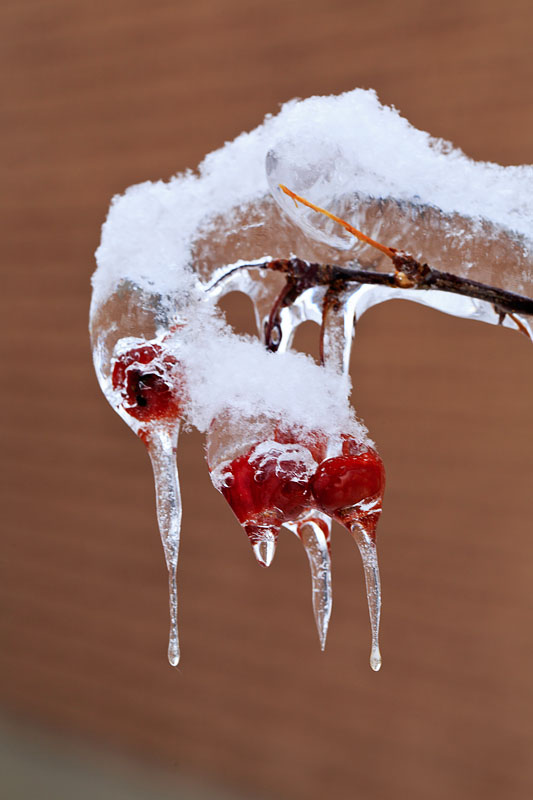
f/2.8 ISO 100 1/125 sec (minimum depth of field, bricks unrecognizable however crabapples not in focus due to extremely shallow depth of field)
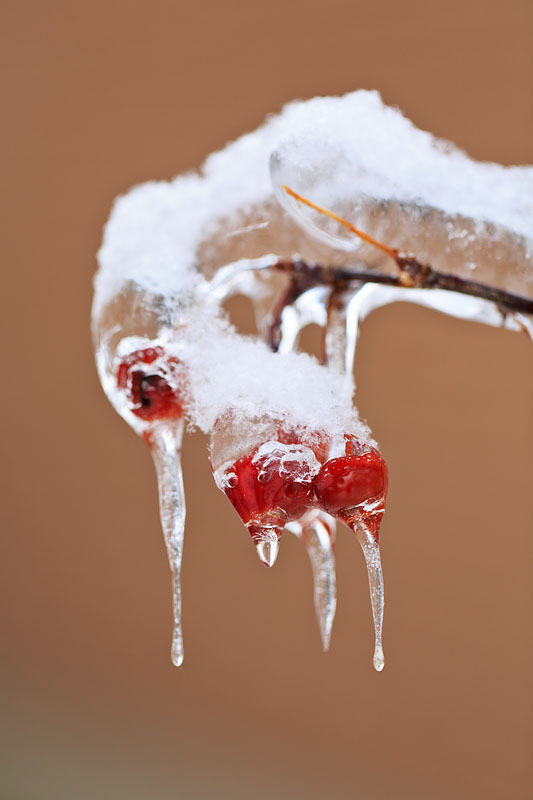
Some may prefer the f/2.8 image while others may prefer the f/10 version as more of the object remains in good focus. A little bit of photoshop on the f/10 version improves the image about as much as can be accomplished given the colour of the brick BG.
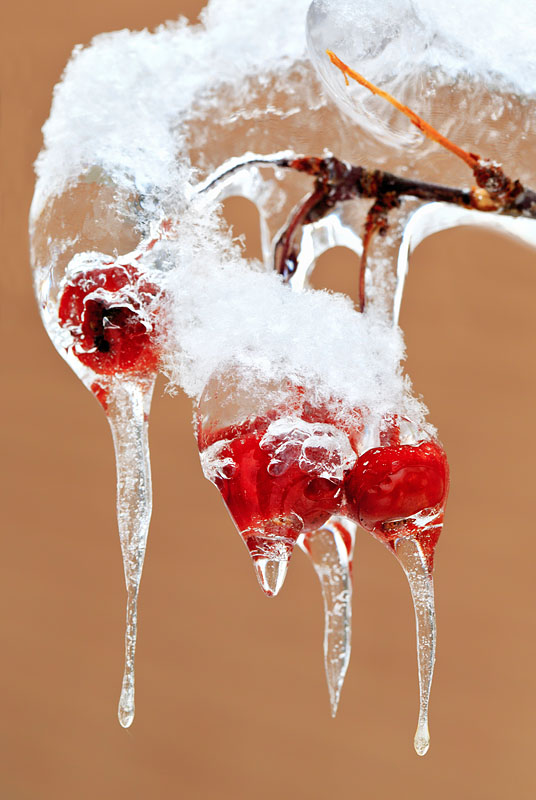
Not being happy with the colour of the BG I decided to use a 48″ white/silver reflector (which is typically used to reflect light onto a person during portrait photography) to create the appearance of a snowy BG. Intuitively I selected the white reflecting surface which produced the following result.
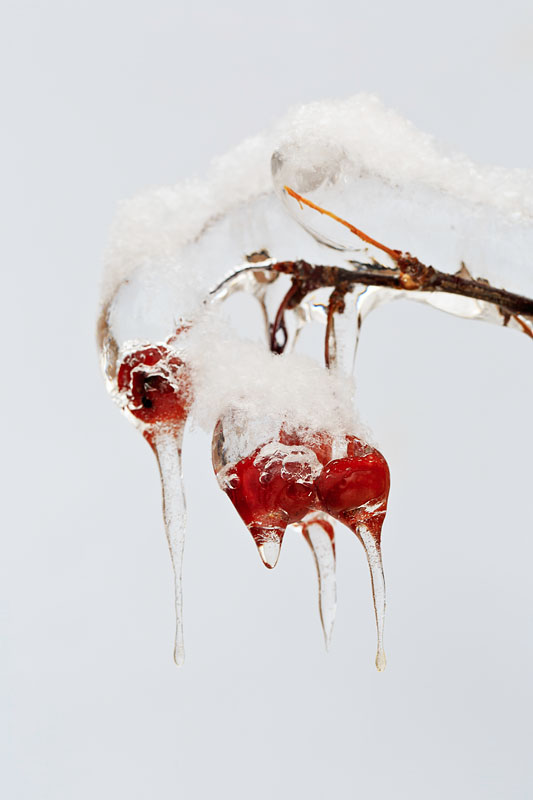
Although this is an improvement, all the detail in the ice covering the branches is lost and the structure within the icicles is greatly reduced using the white reflector. This led me to try something that was quite counter intuitive which was to use the highly reflective silver reflector and take the shot one more time which produced the results shown in the first image which has lots of detail in the ice, snow flakes and icicles that was absent using the white reflector. Here it is again with a little text in keeping with the date today.
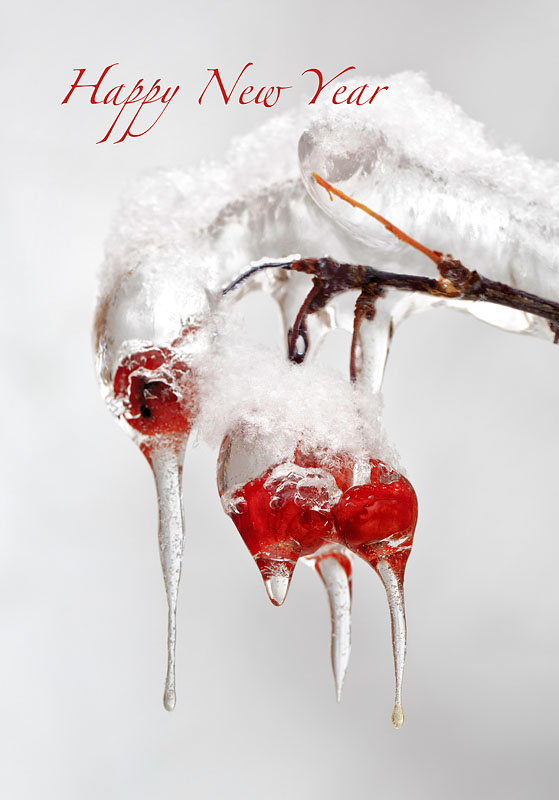
The above image was relatively simple to take in that separating the subject from the BG was easy, the back ground was uncluttered and there was even room to place our own BG into the image. It may have taken some time and experimentation but the process was not a difficult one…..you just have to do it 🙂 But what about situations where you are faced with a cluttered BG that can not be separated from the object? In that case all we have to play around with is the depth of field which we do by changing the aperture of the lens. Remember: larger aperture (lower f-stop) has a shallow DOF while a smaller aperture (higher f-stop) has a deeper DOF. As an aside, focal length of the lens also affects DOF. A wide angle lens (shorter focal length) has a greater DOF than a telephoto lens (longer focal length) at the same aperture.
Here is a different branch of our Crabapple tree with a very cluttered and close BG in which I’ve purposely positioned the object branch at an angle to the lens which makes DOF considerations all the more challenging.
The first image f/32 ISO 100 1/2 sec. Things are in focus but there is no obvious object to be found. An all around poor image which even includes the windows and bricks on our house.
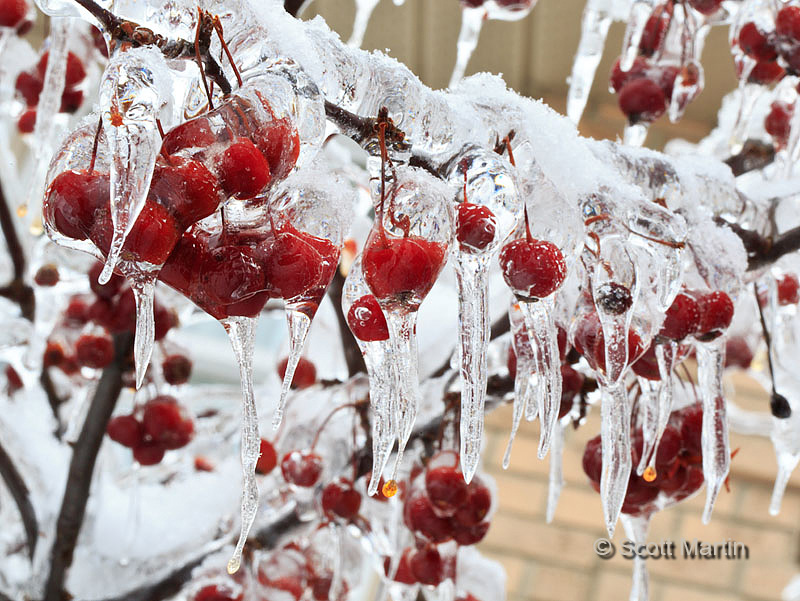
At f/2.8 ISO 100 1/320 sec things start to improve, an object is clearly identified but compositionally it is in the middle of the frame….a big mistake.
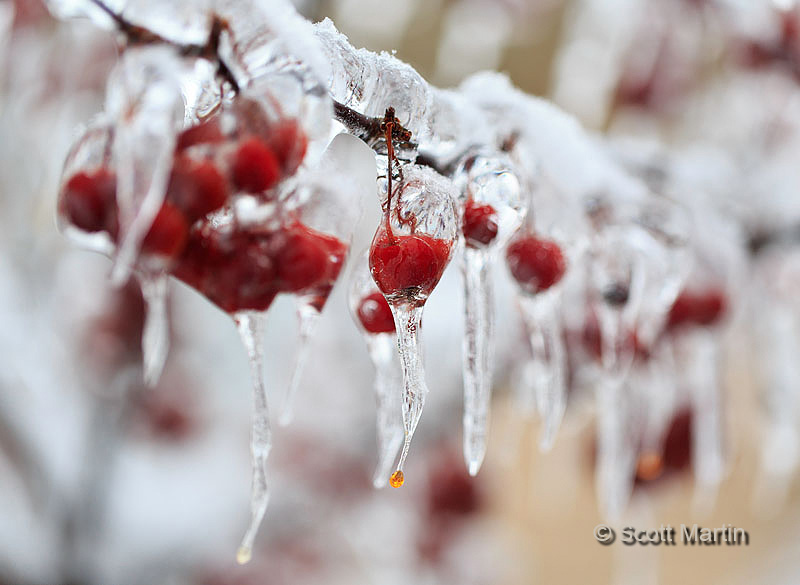
Focusing on the Crabapple cluster in the left of the frame at f/2.8 to improve the composition doesn’t work well as the DOF is so shallow you can not visually lock onto the object and therefore the image does not hold any interest.
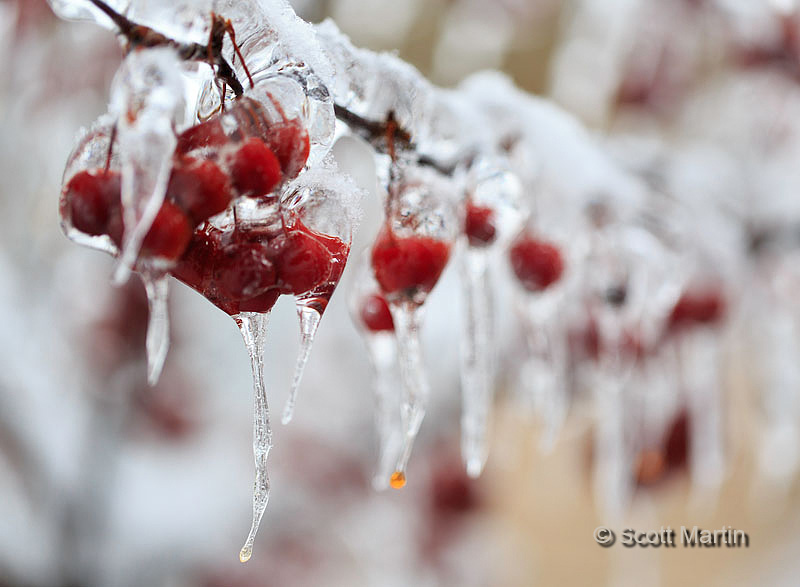
So what can you do? Probably the best thing to do at this point is to agree that the ‘perfect shot’ is not coming from this set up and move on, however with todays digital files and photoshop we can quite easily blend multiple images into one final image. The most complicated form of this process is know as focus stacking where one will take tens (or even hundreds) of images of the same subject slowly moving the focus point from the front to the back of the object and then put all these images together to create an image where the entire object appears in perfect focus even though each individual image in the stack had a very shallow DOF. The simplest form of this process (and the least desirable in terms of results) is to put two images together. This last image is a blending of the f/32 and f/2.8 images above. If you look closely you will see the downside of the two image process but I trust this example shows the possibilities exist so that with patience and thinking things through you can often achieve results that will turn your snapshots into photographs!
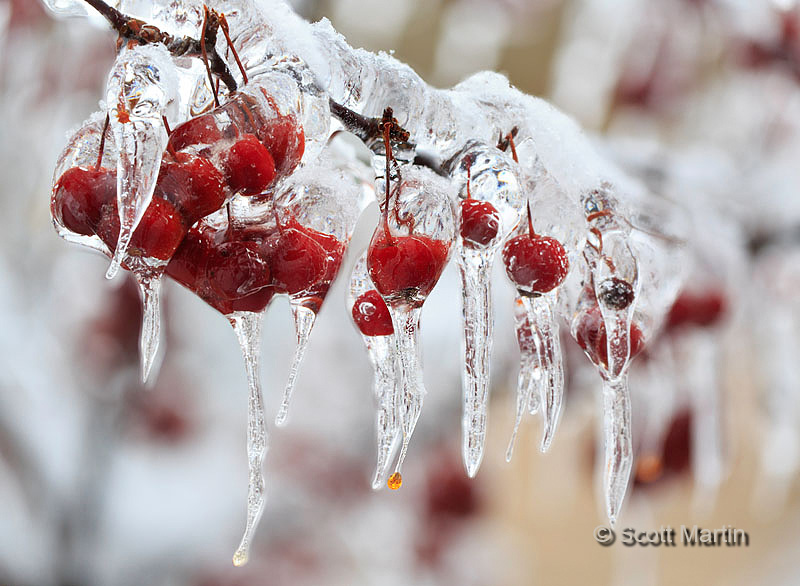
I trust this was a helpful post and now its back to working on posts of our European trip.
Happy New Year!


































Follow Scott Martin Photography